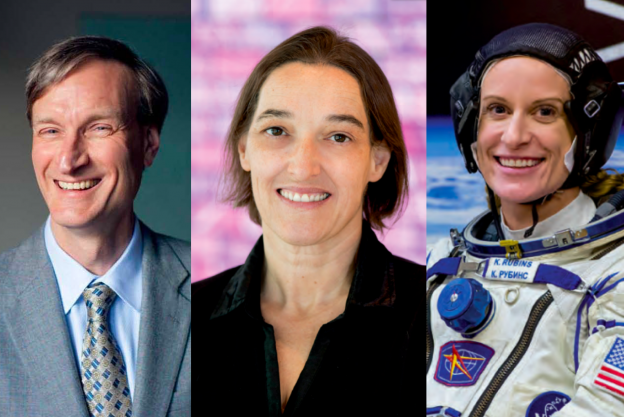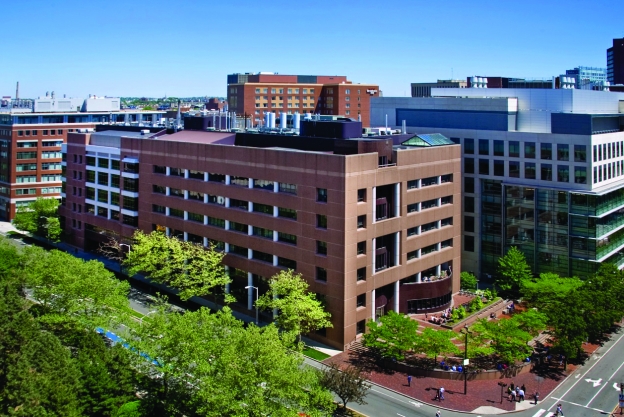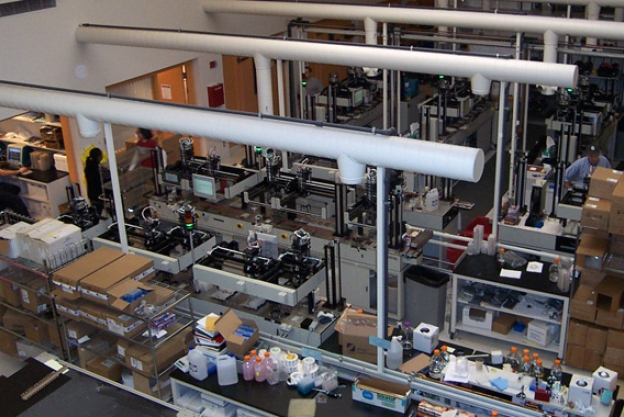About Us
Whitehead Institute science is Science without limits.
Not bound to a particular research area or disease focus, we empower our scientists to be nimble, free to pursue the big questions; letting their interests evolve and draw from any discipline to which they lead. From artificial intelligence to neuroimmunity, Whitehead Institute does science at the interface between disciplines.
A common denominator is our strong basic science approach, enabling a mechanistic understanding of biological processes crucial to understanding health and disease at its most elemental levels, essential for reconstituting the complexity with which organisms function. We believe that understanding this complexity is essential to identifying the causes of disease and developing evidence-based therapies.
Jack Whitehead and David Baltimore founded Whitehead Institute in 1982 with a goal of uncovering fundamental principles in developmental biology. The Institute’s Founding Members, and those that joined subsequently, embraced the charge and since its inception, the Institute has been instrumental in some of the most significant accomplishments in biomedical science including the human genome project and the discovery of the first oncogene. Our path of discovery has now led us to the natural progression of our focus on development—the biology of renewal and resilience.
Understanding our scientific vision, Renewal and Resilience, means understanding how an organism performs the fundamental tasks of life—replenishing its cells and tissues, reproducing—as well as the adaptive responses by the organism to challenge. What happens when its systems are perturbed, or stressed?
Renewal and Resilience touches the research of each of our principal investigators. Their laboratories work on questions ranging from how our germ cells renew and replenish our genetic material to studying connections between aging and hibernation and torpor; from learning how some organisms regenerate organs and functions to understanding the genetics underlying sex differences in health and disease; and from spurring immune cells to fight cancer to developing more productive and resilient food crop plants.
Whitehead Institute scientists transcend disciplines, pursuing their interests without limits and meeting biological complexity with the incisive context needed to uncover the big picture of a healthier tomorrow.

Whitehead Institute’s mission is to forge new frontiers in science, uncovering insights today that unlock the potential of tomorrow.

Whitehead Institute was founded by visionary industrialist and philanthropist Edwin C. “Jack” Whitehead, who was driven by a singular vision: to assemble a cadre of the world’s finest biomedical researchers under one roof and eliminate virtually any impediment to their pursuit of scientific discovery. Nobel Laureate David Baltimore was appointed as the Institute’s founding director, and was joined by Founding Members Gerald Fink, Rudolf Jaenisch, Harvey Lodish, and Robert Weinberg. Baltimore served as director until 1990, when he became president of Rockefeller University; in 1997, he became president of California Institute of Technology. He was awarded the National Medal of Science in 1999.

The Whitehead Fellows Program was established: a unique vehicle for accelerating the careers of the world’s most promising young investigators, it enables newly minted doctoral researchers to create and run their own research laboratory. Whitehead Fellows have gone on to distinguished careers, becoming leaders in prestigious academic and corporate research programs around the world. Their numbers include renowned scientists such as the globally respected MIT and HHMI cancer researcher Angelika Amon, Harvard Medical School dean George Daley, Broad Institute director Eric Lander, and NASA astronaut Kate Rubins—as well as four current Whitehead Institute Members: David Page (the inaugural Fellow), David Bartel, David Sabatini, and Sebastian Lourido.

The Institute’s state-of-the-art facility is opened, spurring the growth of what has become the pioneering Kendall Square life sciences research, innovation, and entrepreneurship community.
The Institute was recognized as the top research center in the world in molecular biology and genetics, based on the impact of its scientific publications—according to the Institute for Scientific Information in Philadelphia.
Gerald R. Fink succeeded Baltimore as director. During his tenure (which lasted until 2001), he implemented a strategic plan designed to respond to dramatic shifts in the practice of biomedical science and to continue supporting new ideas at the very earliest stage of development—taking a chance on brilliant young scientists eager to extend the boundaries of their chosen fields. And he led planning for a state-of-the-art research wing with expanded biologic containment laboratories for research on HIV/AIDS, tuberculosis, common fungal diseases and bacterial infections; and increased space for young Whitehead faculty who were rapidly becoming leaders in their respective fields. In 2001, Fink returned his full-time focus to his lab and continued to make important discoveries on topics such as pathogenic fungi, hormone signaling, and RNA biology. He also served as president of the Genetics Society of America and of the American Association for the Advancement of Science.

The Institute opened a new, state-of-the-art research wing, enabling its scientists to accelerate research programs focusing on cancer, human genetics, AIDS, tuberculosis, and basic developmental biology. Overall, the new wing increased space for research and training by more than 45 percent. It included expanded biologic containment facilities for infectious disease research, increased capacities for studying mouse models of human disease, and new facilities for molecular medicine.
Founding Member Robert Weinberg received the National Medal of Science for his pioneering work on cancer genetics, including his discoveries of the first human oncogene—a gene that causes normal cells to form tumors—and the first tumor suppressor gene. His current work primarily focuses on the interactions between epithelial and mesenchymal cells that produce carcinomas and on the processes by which cancer cells invade and metastasize.

Susan L. Lindquist succeeded Fink as director, joining Whitehead Institute from University of Chicago where she was Albert D. Lasker Professor of Medical Sciences, professor of Molecular Genetics and Cell Biology, and a Howard Hughes Medical Institute Investigator. As director she accomplished a major strategic refocusing of Institute research and resources: spinning off the Whitehead Institute/MIT Center for Genome Science in 2003 (see next item). She explained that, “Like proud parents, we realized it needed the freedom to realize its best potential. It also seemed the right time to refocus on Whitehead’s core mission”—focusing broadly on basic biomedical research. Having accomplished that task, she returned to full time research in 2004 and continued making ground-breaking contributions in genetics, cell biology and biochemistry—using organisms as diverse as fungi, fruit flies, and mustard plants. Through the example of her career and through her personal engagement, she also fostered the careers of women determined to fulfill their potential as scientists.

Between 1990 and 2003, scientists at Whitehead Institute/MIT Center for Genome Science helped shape the field of genomics—ultimately making the single largest contribution to the Human Genome Project. In addition to sequencing the human genome, the Center played a leadership role in sequencing key model organisms such as the mouse; it devised new genomic strategies for cancer diagnosis; and it developed methods for mapping disease across human populations. In November 2003, the Center—which had grown to a $100 million organization with 300 staff members—was spun off into the independent organization known today as the Broad Institute of MIT and Harvard.
David C. Page succeeded Lindquist as director, leading the Institute into the post-genomic era. Page, who was the first Whitehead Fellow and became a Member in 1988, served as director from 2005 through June 2020. During his tenure, he made a mark on all facets of the Institute. Notably, he oversaw creation of the Intellectual Property Office; strengthened core facilities; established new platforms, such as the Metabolomics Center; and enhanced the leadership structure by appointing three associate directors. Perhaps most important, he guided a robust renewal of faculty and helped prepare the organization for generational change in its senior membership—with nine Institute Members being appointed under his leadership (along with 14 Whitehead Fellows). In July 2020, Page returned his full focus to research on the role of sex chromosomes in health and disease, which holds the potential to fundamentally improve the practice of medicine.

Member and former director Susan Lindquist received the National Medal of Science for her studies of protein folding, demonstrating that alternative protein conformations and aggregations can have profound and unexpected biological influences, facilitating insights in fields as wide-ranging as human disease, evolution, and biomaterials.
Founding Member Rudolf Jaenisch received the National Medal of Science for improving our understanding of epigenetic regulation of gene expression: the biological mechanisms that affect how genetic information is variably expressed. His work has led to major advances in our understanding of mammalian cloning and embryonic stem cells. His current work focuses on understanding the epigenetic regulation of gene expression in mammalian development and diseases, including Parkinson’s, autism spectrum disorders, and Rett and Fragile X syndromes; and his lab has used patient-derived induced pluripotent stem cells to develop sophisticated models of conditions, such as Alzheimer’s disease and diabetes.
Johnson & Johnson honored the memory and achievements of former director Susan Lindquist (who tragically passed away in October 2016) by endowing the Susan Lindquist Chair for Women in Science at Whitehead Institute, to be awarded to a distinguished female scientist who is advancing biomedical research. The chair’s first incumbent will be Yukiko Yamashita, a globally renowned researcher who joined the Institute in September 2020.
Ruth Lehmann, a world renowned developmental and cell biologist, succeeded Page as director. Previously, Lehmann was the Laura and Isaac Perlmutter Professor of Cell Biology and Chair of the Department of Cell Biology at New York University (NYU), where she also directed the Skirball Institute of Biomolecular Medicine and The Helen L. and Martin S. Kimmel Center for Stem Cell Biology. She was also an Investigator of the Howard Hughes Medical Institute. The appointment represented a homecoming: Lehmann was a Whitehead Institute Member from 1988 to 1996, before beginning her distinguished 24-year career at NYU. In announcing Lehmann’s appointment, Charles D. Ellis, then-chair of the Whitehead Institute board of directors observed, “Ruth Lehmann perfectly fits our vision for the next director: an eminent scientist and experienced leader, who is passionately committed to Whitehead Institute’s mission and possesses a compelling vision for basic biomedical research in the coming decade.”

In summer of 2020, Whitehead Institute board of directors elected Sarah Keohane Williamson as its next chair. Williamson is CEO of FCLTGlobal, a not-for-profit working to increase innovation, economic growth, and savings by encouraging long-term behaviors in business and investing. She possesses three decades’ experience in leadership and management, and has built extensive working relationships with business leaders around the globe. Williamson succeeds Charles D. Ellis, the founder of international strategy consulting firm Greenwich Associates and a prolific author, who has served as chair since 2006.
Chaired by Sarah Williamson, the Institute’s Board of Directors plays a vital governance role. The Board’s 15 active members participate on a variety of working committees throughout the year and meet quarterly as a full body.
Ruth Lehmann, a world renowned developmental and cell biology researcher, took over as Whitehead Institute’s fifth Director in 2020.
Whitehead Institute's scientists are world-famous for their discoveries in genetics, genomics, stem cells, cancer, and developmental biology. Come join us as we rewrite textbooks and redefine our understanding of biology.
Whitehead Institute is located in the biotech and biomedical hub of Kendall Square in Cambridge, MA.
The Whitehead Institute campus features five floors of laboratory space, as well as state-of-the-art facilities for genomics, computing, microscopy and more.
This monthly program provides educators an opportunity to explore topics at the forefront of biomedical research.
This program exposes students to cutting-edge topics in biomedical research.
Delve into the amazing biology that thrives in the world around us during a two-week, fully immersive experience where curiosity meets real world science.
Featuring prominent leaders in the field of biomedical research, this speaker series engages the broader Whitehead Institute, MIT, and Kendall Square communities with timely discussions of developments in venture capital funding, biomedical research advances, and issues affecting biotech start-ups.






